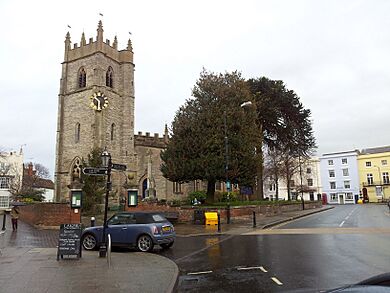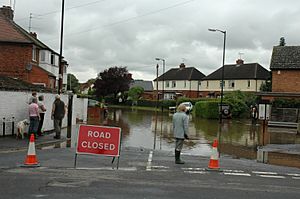Alcester facts for kids
Quick facts for kids Alcester |
|
|---|---|
 Alcester's High Street |
|
| Population | 6,035 (2021) |
| OS grid reference | SP0957 |
| Civil parish |
|
| District |
|
| Shire county | |
| Region | |
| Country | England |
| Sovereign state | United Kingdom |
| Post town | ALCESTER |
| Postcode district | B49 |
| Dialling code | 01789 |
| Police | Warwickshire |
| Fire | Warwickshire |
| Ambulance | West Midlands |
| EU Parliament | West Midlands |
| UK Parliament |
|
Alcester is a busy market town in Warwickshire, England. It is about 8 miles west of Stratford-upon-Avon. The town is built where the River Alne and River Arrow meet.
In 2021, about 6,035 people lived in Alcester.
Contents
What's in a Name?
The name Alcester comes from the River Alne. The word 'cester' means a Roman fort or town. It comes from the Old English word 'ceaster'. This word itself comes from the Latin 'castrum', which is also where our word 'castle' comes from.
A Look Back in Time
Roman Alcester
The Romans first built Alcester around AD 47. It started as a walled fort. This walled town might have been called Alauna. It grew along Icknield Street, a major Roman road. This road went all the way from south-west England to south Yorkshire.
By the late 100s, Roman Alcester was a busy trading town. It had a small walled area in the center. Around it were many roads leading to workshops and homes. People here worked with leather, metal, and made pottery. Some Roman houses even had heating, painted walls, and mosaic floors! The town started to decline in the 300s when the Romans left Britain. Archaeologists began studying Alcester in the 1920s.
Medieval Times and Alcester Abbey
In the Early Middle Ages, Alcester was an Anglo-Saxon market town. It was part of the Kingdom of Mercia.
Alcester was also home to Alcester Abbey. This was a Benedictine monastery built in 1138. Over time, the Abbey was not well cared for. By 1515, it was in ruins. Later, during the time of King Henry VIII, it was mostly torn down. The stones were used to rebuild a nearby family home called Beauchamp Court.
Cool Buildings to See
Alcester has buildings from many different times. You can see Medieval, Tudor, Georgian, and Victorian styles. The oldest house is likely The Old Malthouse. It was probably built around 1500.
St Nicholas's Church is a very old and important building. Its clock is in a unique spot on the corner of the tower. This was so people on the High Street could see it easily. The church also has the tomb of Fulke Greville, a famous poet and statesman.
Alcester Town Hall was built between 1618 and 1641. It is also a very important historic building.
Getting Around Alcester
Alcester used to have a train station. It was part of a line that connected many towns. Another train line also ran from Alcester to Stratford-upon-Avon. However, these train lines closed down in the 1930s and 1960s.
Today, Alcester has bus services. The X19 bus runs every hour between Redditch and Stratford-upon-Avon. Another bus, the 247, also travels through Alcester.
Fun Places to Visit
Alcester is close to two grand old houses. To the north is Coughton Court. This historic home is now looked after by the National Trust. To the south-west is Ragley Hall. It has beautiful gardens and a fun adventure playground for kids!
Near Alcester is Kinwarton. It has an old church and a historic dovecote. This dovecote is also a National Trust property. Alcester is also on the Heart of England Way, a long walking trail.
You can also visit 'Roman Alcester'. This museum shows amazing objects found in the area. These items are from the 1st to 4th centuries. The museum opened 20 years ago in 2004.
Yearly Events in Alcester
Alcester has many fun events throughout the year:
- In early June, there's the Court Leet charity street market. It has a procession and competitions.
- In October, Alcester holds an annual mop fair. This fair has amusement rides, games, and food stalls.
- The Alcester and Forest of Arden Food Festival happens every May and October.
- The St Nicholas Night Fair is held on December 6th.
- A yearly duck race takes place in July. It raises money for the town's summer decorations and Christmas lights.
Dealing with Floods
The River Alne and Arrow meet near Alcester. Sometimes, these rivers have flooded parts of the town. Big floods happened in 1956, 1998, and 2007. In 2007, about 200 homes were damaged.
To help prevent future floods, Alcester built a large underground storage tank. It can hold 3.25 million liters of water! This project cost over £1 million and was finished in 2011.
Sports in Alcester
Alcester has several sports clubs. Alcester Town F.C. is the local football club. It has teams for all ages, from young kids to adults. There is also a rugby club in town.
Alcester & Ragley Park Cricket Club plays cricket in the beautiful grounds of Ragley Hall. They have both adult and junior teams. Alne Cricket Club is also nearby and offers cricket for children and adults.
Local News and Media
You can watch local news from BBC West Midlands and ITV Central. For radio, there are stations like BBC CWR and Heart West Midlands. The local newspaper is the Redditch Advertiser.
Schools in Alcester
Alcester has three secondary schools:
- Alcester Grammar School
- Alcester Academy
- St Benedict's Catholic High School
Places to Worship
- St Nicholas Church
- Our Lady & St Joseph's Roman Catholic Church
- Alcester Baptist Church
- Alcester Methodist Church
- Kingdom Hall of Jehovah's Witnesses
Famous People from Alcester
- Howard Bennett, a cricketer
- Russell Brookes, a rally driver
- Fulke Greville (1554–1628), a famous poet
- Frederick George Jackson, an Arctic explorer
- Nick Skelton, an Olympic Gold Medal winner
Town Friends Across the Sea
Alcester is twinned with Vallet in France. This means they are friendly partner towns.
See also
 In Spanish: Alcester para niños
In Spanish: Alcester para niños





